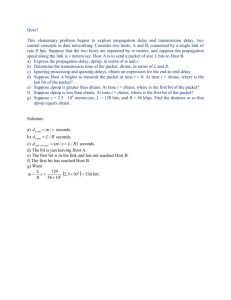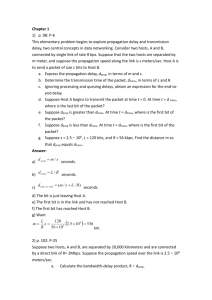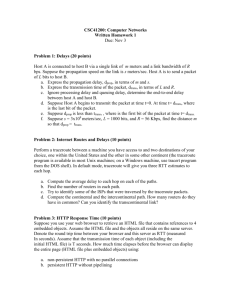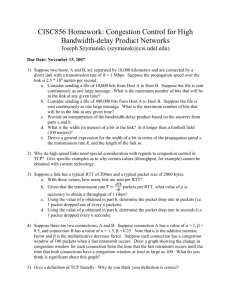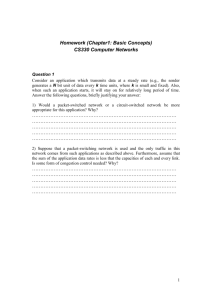this version
advertisement
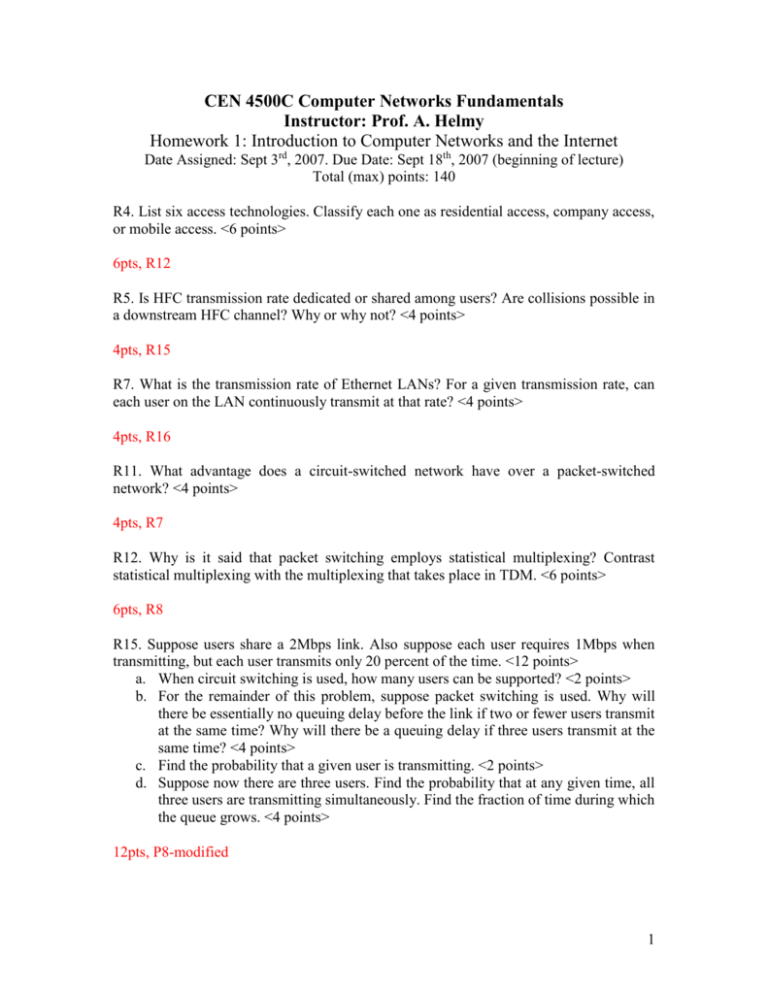
CEN 4500C Computer Networks Fundamentals Instructor: Prof. A. Helmy Homework 1: Introduction to Computer Networks and the Internet Date Assigned: Sept 3rd, 2007. Due Date: Sept 18th, 2007 (beginning of lecture) Total (max) points: 140 R4. List six access technologies. Classify each one as residential access, company access, or mobile access. <6 points> 6pts, R12 R5. Is HFC transmission rate dedicated or shared among users? Are collisions possible in a downstream HFC channel? Why or why not? <4 points> 4pts, R15 R7. What is the transmission rate of Ethernet LANs? For a given transmission rate, can each user on the LAN continuously transmit at that rate? <4 points> 4pts, R16 R11. What advantage does a circuit-switched network have over a packet-switched network? <4 points> 4pts, R7 R12. Why is it said that packet switching employs statistical multiplexing? Contrast statistical multiplexing with the multiplexing that takes place in TDM. <6 points> 6pts, R8 R15. Suppose users share a 2Mbps link. Also suppose each user requires 1Mbps when transmitting, but each user transmits only 20 percent of the time. <12 points> a. When circuit switching is used, how many users can be supported? <2 points> b. For the remainder of this problem, suppose packet switching is used. Why will there be essentially no queuing delay before the link if two or fewer users transmit at the same time? Why will there be a queuing delay if three users transmit at the same time? <4 points> c. Find the probability that a given user is transmitting. <2 points> d. Suppose now there are three users. Find the probability that at any given time, all three users are transmitting simultaneously. Find the fraction of time during which the queue grows. <4 points> 12pts, P8-modified 1 R16. Consider sending a packet from a source host to a destination host over a fixed route. List the delay components in the end-to-end delay. Which of these delays are constant and which are variable? <4 points> 4pts, R19 R19. Suppose Host A wants to send a large file to Host B. The path from Host A to Host B has three links, of rates R1=500kbps, R2=2Mbps, and R3=1Mbps. <8 points> a. Assuming no other traffic in the network, what is the throughput for the file transfer. <2 points> b. Suppose the file is 4 million bytes. Roughly, how long will it take to transfer the file to Host B? <2 points> c. Repeat (a) and (b), but now with R2 reduced to 100kbps. <4 points> 8pts, New Question R23. What are the five layers in the Internet protocol stack? What are the principal responsibilities of each of these layers? <10 points> 10pts, R21 R25. Which layers in the Internet protocol stack does a router process? Which layers does a link-layer switch process? Which layers does a host process? <6 points> 6pts, R23 Q. How would you describe the overall structure of the Internet? <6 points> What is the advantage of having such a structure? (Mention at least 2 items) <6 points> 12pts, New Question Q. What is the advantages and disadvantages of having a layered protocol architecture for the Internet? (mention at least 3 advantages and 2 disadvantages) <10 points> Is it true that the change in any of the layers does not affect the other layers? (support your answer/arguments with examples) <4 points> 14pts, New Question P5. Two hosts, A and B, connected by a single link of rate R bps. Suppose that the two hosts are separated by m meters, and that the propagation speed is s m/s. Host A is to send a packet of size L bits to host B. <18 points> a. Express the propagation delay, dprop, in terms of m and s. <3 points> b. Determine the transmission time of the packet, dtrans, in terms of L and R. <3 points> c. Obtain an expression for the end-to-end delay (ignore queuing and processing delays). <3 points> 2 d. Suppose A begins to transmit the packet at time t=0. At time t=dtrans, where is the last bit of the packet? <2 points> e. Suppose dprop is greater than dtrans. At time t=dtrans, where is the first bit of the packet? <2 points> f. Suppose dprop is less than dtrans. At time t=dtrans, where is the first bit of the packet? <2 points> g. Suppose s=2.5·108 m/s, L=100 bits, and R=28kbps. Find the distance m so that dprop equals dtrans. <3 points> 18pts, P6 P24. In modern packet-switched networks, the source host segments long, applicationlayer messages (for example, an image or a music file) into smaller packets and sends the packets into the network. The receiver then reassembles the packets back into the original message. We refer to this process as message segmentation. Figure 1.24 illustrates the end-to-end transport of a message with and without message segmentation. Consider a message that is 7.5x106 bits long that is to be sent from source to destination in Figure 1.24. Suppose each link in the figure is 1.5Mbps. Ignore propagation, queuing, and processing delays. <14 points> a. Consider sending the message from source to destination without message segmentation. How long does it take to move the message from the source host to the first packet switch? Keeping in mind that each switch uses store-and-forward packet switching, what is the total time to move the message from source host to destination host? <3 points> b. Now suppose that the message is segmented into 5,000 packets, with each packet being 1,500 bits long. How long does it take to move the first packet from source host to the first switch? When the first packet is being sent from the first switch to the second switch, the second packet is being sent from the source host to the first switch. At what time will the second packet be fully received at the first switch? <3 points> c. How long does it take to move the file from source host to destination host when message segmentation is used/ Compare this result with your answer in part (a) and comment. <4 points> d. Discuss the drawbacks of message segmentation. <4 points> 3 14pts, P20 [R26~R28]: Chapter 8 related R26. What is the difference between a virus and a worm? <6 points> 6pts, New Question R27. How can a distributed denial of service (DDoS) attack be created? <6 points> 6pts, New Question R28. Alice and Bob send packets to each other over a network, while Trudy is positioned such that she can capture all the packets sent by Alice and Bob and send whatever she wants to Bob and Alice. List at least three of the malicious things Trudy can do. <6 points> 6pts, New Question 4
